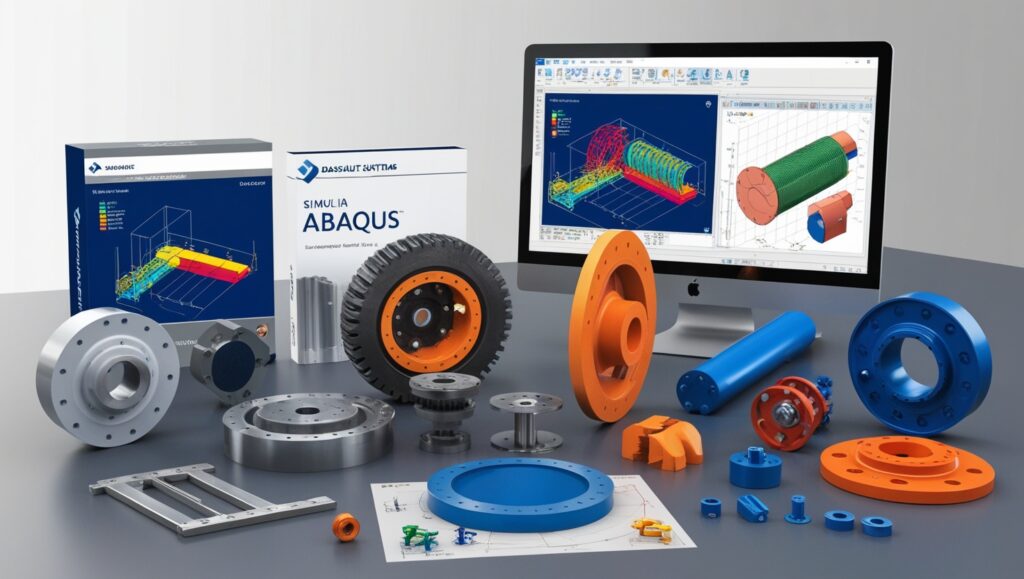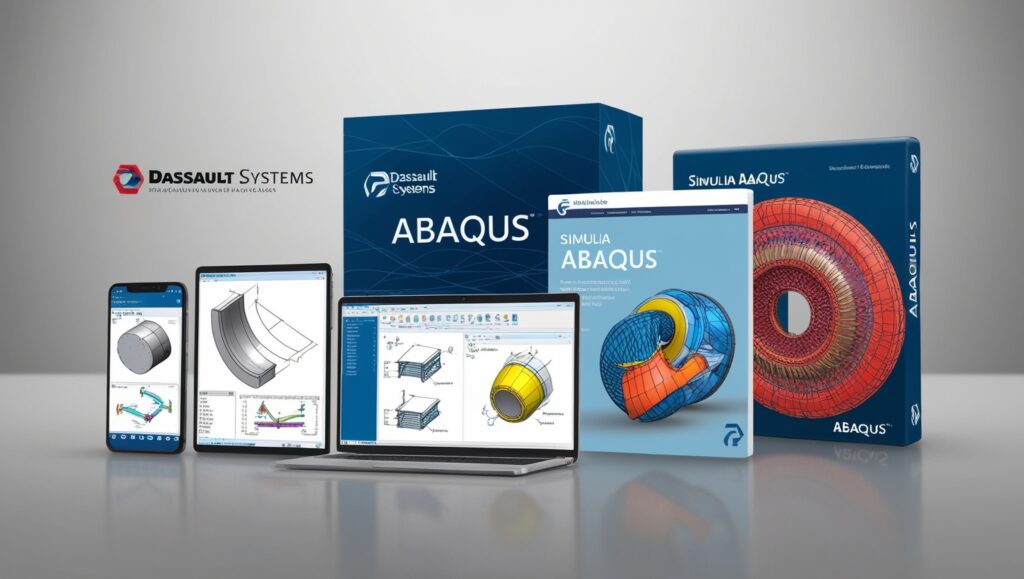
Introduction
Simulia Abaqus is a sophisticated software suite developed by Dassault Systems, primarily utilized for finite element analysis (FEA) across various engineering fields, including aerospace, automotive, and civil engineering. Renowned for its advanced simulation capabilities, Abaqus enables engineers to model and analyze the behavior of materials and structures under diverse loading conditions, offering both static and dynamic analysis, as well as fatigue and progressive damage assessments.
Its versatility and robustness make it a crucial tool for optimizing designs, enhancing safety, and reducing costs associated with experimental testing by predicting performance prior to physical prototyping. The software comprises multiple modules that facilitate a comprehensive modeling and analysis workflow, including the Abaqus Scripting Interface for automation and customization, as well as seamless integration with popular CAD systems such as SolidWorks and CATIA, thereby streamlining the design-to-simulation process.
Abaqus supports complex engineering challenges through advanced analysis techniques, such as nonlinear material models and thermal-stress simulations, ensuring its relevance in solving intricate problems across various sectors. Notably, the licensing and pricing structure of Abaqus is a point of discussion among users, as it tends to be higher compared to competitors like Ansys. However, many users justify the investment due to its superior capabilities, particularly in nonlinear simulations and comprehensive support services.
Additionally, the recent acquisition of Abaqus by Dassault Systems in 2005 has expanded its integration within a broader portfolio of simulation solutions, further enhancing its capabilities and user support. Despite its acclaim, some users have reported challenges related to the software’s complexity and learning curve, which can deter new users. Nevertheless, the extensive community support and available resources significantly aid in overcoming these hurdles, making Abaqus a leading choice among professionals and academics alike.
Overview
Simulia Abaqus is a robust software suite designed for finite element analysis (FEA), enabling engineers to simulate the behavior of structures and materials under diverse loading conditions. It is particularly known for its versatility, offering capabilities for static and dynamic analyses, fatigue assessment, and progressive damage analysis of materials and structures. Abaqus is extensively utilized in various industries, including aerospace, automotive, and civil engineering, providing solutions for both linear and nonlinear problems.
The software facilitates comprehensive design optimization, allowing users to explore a wide range of variables and their interactions, which is often beyond the reach of traditional single-physics simulations. One of the significant advantages of using Abaqus is its ability to reduce costs associated with experimental testing by predicting performance before physical prototypes are built. Additionally, the software supports rapid iterations of design based on simulation feedback, which accelerates the product development process.
Abaqus comprises several modules that guide users through the modeling and analysis process. For experienced users, the Abaqus Scripting Interface allows for enhanced functionality, enabling automation of tasks and parameterization of models. The integration capabilities with other design software, such as Pro/ENGINEER and SolidWorks, further streamline the modeling process by allowing real-time updates and modifications to be reflected in Abaqus.

Features
Abaqus is renowned for its extensive capabilities in finite element analysis (FEA), making it a preferred choice for engineers and researchers in various fields.
Substructure Visualization
When substructure visualization is enabled during usage analysis, Abaqus/Standard automatically generates display elements that represent substructures. These display elements are independent of the usage analysis mesh and do not influence simulation outcomes. They primarily offer translational displacement degrees of freedom and can depict the deformed state of the substructure throughout the analysis. This functionality enhances the understanding of substructure behavior, aiding in result interpretation during static, dynamic, eigenvalue extraction, and linear dynamic analysis procedures.
Output Types
Abaqus provides two primary categories of outputs: field outputs and history outputs. Field outputs deliver crucial data on variables such as stress, strain, and displacement across the model at designated increments, which is vital for comprehending overall behavior. In contrast, history outputs focus on time-dependent variables at specific points, facilitating in-depth analysis of dynamic or transient events. Users can also visualize these outputs through a post-processing module that supports contour plots, graphs, and animations.
Advanced Analysis Capabilities
The software supports a variety of advanced analysis techniques, including nonlinear material models, geometric and material nonlinearities, contact and impact analysis, and fatigue and fracture mechanics analysis. Additionally, it is equipped to handle dynamic simulations and thermal-stress analyses, making it suitable for complex engineering problems.
Scalability and Performance
Abaqus is designed to leverage high-performance computing (HPC) environments, enabling users to perform large-scale simulations efficiently. By utilizing parallel computing capabilities, it optimizes available hardware resources for faster solution times, allowing for the analysis of more complex and computationally intensive problems.
Integration with CAD
Abaqus offers a CAD associative interface that enhances the design-to-simulation workflow, allowing users of popular CAD software like SOLIDWORKS, CATIA, and Creo to streamline their processes. This integration is particularly beneficial for engineers seeking to quickly transition from design to analysis.
Extended Portfolio
The traditional Abaqus license grants users access to additional tools such as fe-safe for fatigue analysis, Isight for parametric optimization, and Tosca for topology optimization, all at no extra charge. This extended portfolio enriches the capabilities of Abaqus, enabling users to tackle a wider array of engineering challenges. Through its robust features and functionalities, Abaqus remains a leading tool in the field of finite element analysis, assisting users in developing innovative solutions to complex engineering problems.

Applications
Simulia Abaqus is widely utilized across various industries for advanced simulation and analysis tasks. Its capabilities enable engineers to address complex challenges, optimizing designs and ensuring safety and reliability in engineering projects.
Automotive Industry
Abaqus has found significant applications in the automotive sector. For instance, an automotive manufacturer used Ansys Workbench, which integrates with Abaqus, to optimize the design of suspension components, leading to enhanced performance and reduced weight. The software also supports the simulation of electric vehicles, requiring an understanding of systems and physics not present in traditional internal combustion engine powertrains, such as electromagnetic fields.
Civil Engineering
In civil engineering, Abaqus is employed for detailed structural analysis. A civil engineering firm utilized it to evaluate the structural integrity of a bridge, considering complex load conditions and material behaviors. This simulation was crucial in ensuring the safety of the bridge. Additionally, Abaqus is used for geotechnical applications, helping to model the behavior of soil and natural materials under various loads, which is essential for projects like dams and tunnels.
Electronics
The consumer electronics industry also leverages Abaqus for thermal analysis. A notable case involved a company simulating the thermal behavior of a mobile device, optimizing its cooling system to prevent overheating. These capabilities demonstrate how Abaqus can be vital in the design and testing of electronic components.
Manufacturing Processes
Abaqus assists in various manufacturing processes, such as soldering, forging, and extrusion, by analyzing thermal-mechanical interactions. These capabilities enable engineers to perform simulations that ensure reliability and efficiency in production processes.
Support for Innovation
Beyond specific applications, Abaqus fosters innovation and collaboration across teams by providing comprehensive visualization options and a robust customization toolset, facilitating the automation of workflows and the deployment of proven processes throughout the engineering enterprise. This integration with platforms like 3DEXPERIENCE enhances its capabilities, allowing for connected, collaborative simulation practices that eliminate traditional silos in engineering processes.
Integration
Associative Interfaces
Abaqus offers a range of associative interfaces that facilitate seamless integration with various CAD systems, enhancing the workflow for users who require concurrent design and analysis. These interfaces allow for the direct transfer of parts and assemblies into Abaqus/CAE, while also enabling users to propagate design modifications back and forth without losing any analysis features assigned to the model.
3DEXPERIENCE CATIA Interface
The Associative Interface for 3DEXPERIENCE CATIA supports automatic associative import, which quickly transfers models between 3DEXPERIENCE CATIA and Abaqus/CAE sessions on the same computer. Users can continue making modifications in 3DEXPERIENCE CATIA and easily distribute these changes to the Abaqus/CAE model with a single click. This interface ensures that features such as partitions, loads, and boundary conditions are regenerated each time a modified model is imported.
NX Interface
Similar to the CATIA interface, the Abaqus/CAE Associative Interface for NX allows for automatic associative imports, enabling swift transfers of models while both applications are running simultaneously. This interface also includes a direct translator for writing NX parts in the Elysium Neutral file format, allowing for further flexibility in model manipulation and updates.
SolidWorks Interface
The SolidWorks Associative Interface permits the transfer of parts or assemblies from SolidWorks into Abaqus/CAE. Users can modify the model in SolidWorks and then propagate these changes back to Abaqus/CAE, maintaining all analysis features during the iteration process. This integration is particularly valuable for engineers iterating on designs based on analysis results from Abaqus.
Pro/ENGINEER Interface
The Pro/ENGINEER Associative Interface provides similar functionality, allowing users to transfer parts and assemblies into Abaqus/CAE using associative import. This interface also features a direct translator for Pro/ENGINEER files and enables users to modify geometric parameters directly from within Abaqus/CAE, ensuring that updates are reflected in both models.
Import Techniques
Abaqus supports multiple import techniques to streamline the CAD-to-Abaqus integration process. Automatic associative import is a key feature, enabling rapid model transfers and ongoing design modifications without needing to recreate analysis features. Additionally, manual associative import is available for scenarios where CAD systems are not running concurrently or are on different computers, allowing users to save assemblies and import them into Abaqus/CAE at a later time.
By utilizing these associative interfaces and import techniques, Abaqus enhances the user experience in simulation and analysis, making it more efficient and user-friendly for engineers working in complex environments.

Licensing and Pricing
Abaqus offers a variety of licensing options tailored to meet the diverse needs of its users. Understanding these options is crucial for organizations to determine the most cost-effective approach to utilizing the software.
Pricing Structure
The cost of Abaqus licenses varies based on the selected type and intended usage. A one-time purchase can range significantly, and users typically also pay a yearly maintenance fee, which is about 20% of the license cost, to receive ongoing support and updates. While the pricing for Abaqus can be higher than some competitors like ANSYS, the advanced capabilities of Abaqus, particularly its robust nonlinear solver, may justify the additional investment for users requiring sophisticated simulation capabilities.
Licensing Options
Abaqus licensing includes both traditional and term options. Traditional Abaqus licenses can be categorized into two types: perpetual licenses and term licenses. Perpetual licenses allow users to maintain access to the software indefinitely, often providing the lowest total cost of ownership over time, especially when combined with subscription services for support and updates.
On the other hand, term licensing offers a more flexible short-term commitment, available for increments of three months or one year, which can be particularly appealing for smaller organizations or those operating in fluctuating business environments.
3DEXPERIENCE Platform
Abaqus is also available through the 3DEXPERIENCE Platform, which includes additional features and capabilities not found in the traditional version. The purchasing process for the 3DEXPERIENCE Structural option may involve distinct differences from the standard licensing approach, potentially influencing the decision-making process for users considering this platform.
Support and Community
In addition to flexible licensing options, Abaqus users benefit from a range of support services. Dassault Systems offers comprehensive customer service, including documentation, technical assistance, and mentoring sessions. Users can also engage with the Abaqus community through various platforms, fostering collaboration and knowledge-sharing among engineers. Ultimately, the choice of licensing and pricing model should align with an organization’s specific needs and usage patterns to maximize the software’s value and efficacy in simulation processes.
Version History
Major Releases
Introduction of New Modules
In 1992, ABAQUS/Explicit, a dynamic explicit analysis package, was launched, complementing the core product known as ABAQUS/Standard, which functions as an implicit finite element solver. The release of ABAQUS/CAE, a pre- and post-processing package, followed in 1999, marking a significant expansion of the software’s capabilities. The first official release of ABAQUS/Explicit was notably hand-delivered to the Massachusetts Institute of Technology (M.I.T.) in the same year.
Company Evolution and Acquisition
As the product line expanded, the company rebranded itself as ABAQUS, Inc. in late 2002 to reflect its focus on this suite of products. A significant milestone occurred in October 2005, when ABAQUS, Inc., with 525 employees, was acquired by Dassault Systems for approximately $413 million, a sum that was about four times the company’s annual revenue of around $100 million. Post-acquisition, ABAQUS became part of Dassault Systèmes Simulia Corp., further integrating its capabilities within a broader portfolio of simulation solutions.
Early Development
The first version of ABAQUS was developed specifically for the Westinghouse Hanford Company to analyze nuclear fuel rod assemblies. ABAQUS version 1 laid the foundation for what would become a comprehensive finite element analysis (FEA) software suite. The subsequent version, ABAQUS version 3, was released in June 1979, primarily focusing on nonlinear static and dynamic analysis of structures, as well as nonlinear steady and transient heat transfer problems. During its initial phase, ABAQUS was distributed through CDC’s Cybernet service.
Recent Developments
The latest versions of ABAQUS continue to enhance functionality and usability. For example, the ABAQUS 2023 release included new features and enhancements across various modules, which were outlined in the release notes. Users gained access to improvements in the query toolset and material enhancements that streamline the analysis process. Previous versions, such as ABAQUS 2019, introduced functionalities like fluid inflator interactions and sensitivity-based shape optimization, showcasing the software’s commitment to evolving with industry needs.
Case Studies
Automotive Component Optimization
An automotive manufacturer utilized Ansys Workbench to optimize the design of a suspension component. This case study demonstrated significant improvements in performance and a reduction in component weight, highlighting the effectiveness of FEA in enhancing automotive designs.
Structural Analysis of a Bridge
A civil engineering firm employed Abaqus for a detailed structural analysis of a bridge, taking into account complex load conditions and material behavior. The simulations performed were critical in ensuring the bridge’s safety and structural integrity, showcasing Abaqus’s capabilities in civil engineering applications.
Thermal Analysis of Electronics
In the consumer electronics sector, a company used Ansys Workbench to simulate the thermal behavior of a mobile device. This analysis helped optimize its cooling system, effectively preventing overheating issues. Such applications illustrate how FEA tools can be vital in ensuring product reliability and performance.
Aerospace Engineering
Abaqus has been pivotal in the aerospace industry, where it simulates the structural integrity of aircraft components under various operating conditions. For instance, analyses of wing deformations and aerodynamic forces are essential for ensuring safety and performance in aerospace structures.
Automotive Design and Safety
In automotive engineering, Abaqus is widely used to simulate crashworthiness and structural integrity. Engineers rely on these simulations to design safer and more fuel-efficient vehicles by predicting component responses to impact scenarios, underscoring the importance of FEA in automotive safety.
Civil Engineering and Structural Analysis
Abaqus serves as a crucial tool in civil engineering for structural analysis and design. It enables engineers to simulate how buildings, bridges, and other structures behave under static and dynamic loads, assisting in optimizing designs for safety and efficiency. These case studies exemplify the diverse applications and successful outcomes achieved through the use of Abaqus and Ansys in real-world engineering scenarios, illustrating their significant role across various industries.
Reception
Simulia Abaqus has garnered significant attention and acclaim within both academic and industrial circles. The software is particularly noted for its advanced capabilities in finite element analysis (FEA), making it a preferred choice among engineers and researchers working on complex structural problems. Feedback on the software has been largely positive, with users highlighting its robust modeling capabilities and the depth of its simulation tools.
User Base
A substantial portion of Abaqus users comes from academia, including professors and graduate students, as well as professionals from various industries such as aerospace, mechanical engineering, and petroleum. This diverse user base reflects the software’s versatility and its application across different fields of engineering. Users appreciate its ability to handle nonlinear behavior in materials, making it useful for a wide range of simulations.
Features and Usability
The introduction of the 2023 release of the SIMULIA product portfolio has further enhanced Abaqus’s appeal by adding new features that improve usability and expand functionality. Users can access resources like the 3DEXPERIENCE Playground and participate in contests like Model Mania, which foster a sense of community and engagement around the software. Moreover, the software’s integration with tools like CATIA and SOLIDWORKS provides a user-friendly interface that facilitates early-stage structural simulations, ultimately leading to cost-effective prototyping and design issue prevention.
Comparisons with Competitors
When compared to its primary competitor, Ansys, Abaqus holds its ground well, offering comparable features and support. Users often consider factors such as application focus, usability, and support when choosing between the two. Both software packages have active user communities that provide valuable resources and support, which enhance the overall user experience and learning curve.
Community and Support
The support infrastructure surrounding Abaqus is robust, with comprehensive documentation, tutorials, and training programs available to users. The active user community allows for knowledge sharing and troubleshooting, which is critical for new users adapting to the software. This level of support contributes to the overall satisfaction among users, who often report a steep but rewarding learning curve associated with mastering the software’s capabilities.



